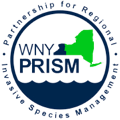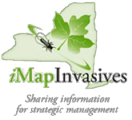favicongohere


WNY PRISM Invasive Species Survey Summary
Prepared by Alexandra Wagner,
WNY PRISM Invasive Species Management Assistant
August 14, 2015
Amherst State Park
The Western New York Partnership for Regional Invasive Species Management (WNY PRISM) is one of 8 partnerships within New York State that was created to address regional invasive species issues. Our mission is to proactively identify, evaluate and address invasive species priorities in western New York using a coordinated partnership of local professionals, organizations and private citizens to improve, restore, and protect local aquatic and terrestrial resources. As part of this mission, we have reached out to regional Partners to survey for the presence of invasive species on their properties and to assist with invasive species management planning. The following summary is intended to give you a broad idea of the invasive species found at Amherst State Park, offer general guidance for prioritization of those species, and provide some best management practices options for treatment. For more information, please visit www.wnyprism.org.
Utilizing the iMapInvasives online database and mapping tool, the WNY PRISM field crew conducted an invasive plant survey at Amherst State Park on June 5, 2015. This survey represents a general assessment of invasive plant species found on the property and does not include every individual plant observed. Many of the GPS/Observations points include a percent cover and spatial distribution for the species indicated. You may view the complete observation data set at www.imapinvasives.org. In order to access this data, you will need to login with your iMapInvasives account. If you do not have an account, you may request one on the iMapInvasives site and complete a short tutorial and quiz. Your new account may take a few days to activate.
Amherst State Park is located on Ellicott Creek, between the village of Williamsville and the Town of Amherst. The park consists of 77 acres of woodlands, meadows, and an orchard. The majority of the land in Amherst State park is within Ellicott Creek’s floodplain, including wetlands inventoried by the U.S. Fish and Wildlife Service. The park has several trails which are frequented by the public. Amherst State Park is also a popular fishing site. Ellicott Creek harbors several species of game fish and in 2012 the park was stocked with rainbow trout.
The WNY PRISM Crew surveyed the park along its trails and footpaths over the course of a full day and invasive species were found throughout the park. Invasive species of highest concern include Japanese knotweed (Reynoutria japonica), yellow flag iris (Iris pseudacorus), Canada thistle (Cirsium arvense), pale swallow-wort (Cynanchum rossicum) and bush honeysuckles (Lonicera spp.). Additional species of concern include lesser celandine (Ranunculus ficaria), multi-flora rose (Rosa multiflora), and reed canary grass (Phalaris arundinacea). WNY PRISM recommends addressing these invasive species as time and funding allows, within the framework of your goals for Amherst State Park.
Tall stands of Japanese knotweed were found growing along the trails at points and along Ellicott Creek. This plant grows rapidly in sunny areas and spreads through rhizomes (underground roots), by seed, or when plant fragments re-establish. Japanese knotweed crowds out native vegetation and interferes with the recreational activities that Amherst State Park visitors enjoy. There are several management options for Japanese knotweed. Digging and/or pulling may be appropriate for small patches, but care must be taken to remove the entire plant. Plant fragments are able to re-sprout. When using any manual or mechanical removal methods make sure to carefully dispose of all plant fragments by placing them in garbage bags and disposing of them in a landfill. Japanese knotweed may also be treated using herbicide through foliar, stem injection, or cut-stem applications, all of which can be highly effective.
Yellow flag iris invades wetlands and riparian habitats, producing dense monocultures that outcompete native vegetation. This plants was found growing in several spots along Ellicott Creek. Smaller patches of yellow flag iris can be dug out of the soil using shovels, but care must be taken to remove the entire root mass and to properly dispose of material, similar to Japanese knotweed. Repeated mowing for several years may suppress patches of yellow flag iris and deplete the plant’s energy. However, mowing may be difficult due to the fact that yellow flag iris prefers wet habitats. Take caution when removing yellow flag iris, by wearing gloves, long sleeves and pants, as the resins from the plant may be a skin irritant. It would be valuable to educate the public about yellow iris. Yellow flag iris is a prohibited species in New York State, though it is a popular plant in water gardens and many members of the public do not understand that it is an invasive species.
Canada thistle produces an extensive, rhizomatous root system, which may extend 20 feet below ground. Repeated mowing and cutting the Canada thistle at the base of the stem for several years may suppress the plant, but their substantial root system allows it to recover from damage. Therefore, cutting or mowing must be done several times a year, in order to stress the plant enough to prevent it from spreading. It is impossible to pull up all of the root of Canada thistle, and
broken rhizomes only encourage the plant to produce more sprouts. Because of this, hand pulling is not a viable treatment option. Herbicide treatment combined with mowing is the most effective treatment.
Pale swallow-wort can form monocultures that outcompete native vegetation in meadows. It can also invade forests where sun reaches through the canopy. Similar enough to milkweeds, monarch butterflies will lay their eggs on this plant. However the caterpillars laid on pale swallow-wort will not survive. Small infestations of pale swallow-wort can be pulled by hand. It is important to dispose of any pale swallow-wort that is pulled in landfill-bound garbage bags, because seeds and root fragments can produce new plants. Cutting or mowing can be used to prevent the plants from producing seeds, although this will not eradicate an infestation and may encourage the plant to spread. Pale swallow-wort can be treated with herbicides in the late summer or fall, but continued management is necessary. Our Crew found pale swallow-wort at a single location and removed the plant by hand-pulling. With early detection, the complete site eradication of pale swallow-wort may be possible. Continued monitoring will be necessary.
Bush honeysuckles were found along woodland edges and trails. This shrub produce leaves early in the year allowing them to outcompete and shade-out native shrubs and trees. Songbirds that nest in honeysuckle tend to nest earlier in the year and lower to the ground, making them more vulnerable to predation. In addition, birds may eat honeysuckle berries, but they do not contain as many nutrients as native plants. The higher fat content of native fruit-bearing shrubs is necessary for birds to store enough energy in order to complete their migration. As a popular birding location, it would be valuable for Amherst State park to educate the public about the negative impacts of honeysuckle and to manage its spread. Smaller shrubs can be pulled but larger shrubs can be treated with herbicides using cut-stump or foliar applications. For information on additional species, please contact WNY PRISM.
Amherst State Park frequently hosts educational walk and talks and is looking into placing additional educational signs within the park. On the included map, you will see 3 areas identified as potential sites for invasive species educational signs. Area 1 may include emerald ash borer, multiflora rose, yellow flag iris and Canada thistle information. From this point you can see several dead ash trees, having died from emerald ash borer (EAB). One fallen ash tree showed obvious signs of EAB damage. Its bark has peeled away revealing the distinctive s-shaped galleries left by the larval beetles. Teaching members of the public to not move firewood when they are traveling will help prevent new infestations. Area 2 may include information on yellow flag iris, japanese knotweed and mugwort. Area 3 may include reed canary grass, garlic mustard, dame’s rocket, Canada thistle, yellow flag iris, multiflora rose and mugwort information.
In total, 28 species were identified and mapped in iMapInvasives. Additional non-native species may have been observed on the property but were not entered into iMapInvasives either because they were not present as an option in the database or because these species are of the lowest priority, such as very common non-native species found in the landscape that have limited harmful impacts. Included in this report you will find the iMapInvasives Project Report and Aerial Map of the site.
PRISM June 5, 2015 Species Report - 28 Species Identified
1. Agrilus planipennis – Emerald Ash Borer
2. Ailanthus altissima – Tree of Heaven, Chinese Sumac, Ailanthus, Varnish Tree, Copa Tree
3. Alliaria periolata – Garlic Mustard
4. Artemisia vulgaris var. vulgaris – Mugwort
5. Cirsium Arvense – Canada Thistle, Creeping Thistle
6. Cirsium vulgare – Bull Thistle
7. Coronilla varia – Common Crown Vetch, Crown Vetch
8. Cynanchum rossicum – Pale Swallow wort, Dog stranging vine, European Swallow wort
9. Daucus carota – Wild Carrot, Queen Anne’s Lace
10. Dipsacus fullonum – Fuller’s Teasel, Common Teasel, Wild Teasel
11. Ficaria verna ssp. Verna – Lesser Celandine, Fig Buttercup
12. Hesperis matronalis – Dane’s Rocket
13. Iris pseudacorus – Yellow Fag Iris, Yellow Iris, Water Flag, Yellow Flag
14. Ligustrum spp. (species unknown) – Privet
15. Lonicera spp. (species unknown) – Honeysuckle
16. Lotus corniculatus – Birdfoot Deervetch, Bird’s Foot Trefoil, Bacon and Eggs, Hen and Chickens
17. Lythrum salicarta – Purple Loosestrife
18. Morus alba – White Mulberry
19. Phalaris arundinacea – Reed Canary Grass
20. Phrgmites australis ssp. Australis – Common Reed, Common Read Grass
22. Rhamnus cathartica – Common Buctkorn
23. Rosa multiflora – Multiflora Rose, Rambler Rose
24. Saponaria officinalis – Bouncing Bet
25. Typha x glauca – Blue Cat-tail, Hybrid Cat-tail
26. Vicia cracca ssp. Tennifolia – Bramble Vetch
Invasive Species in Amherst State Park









